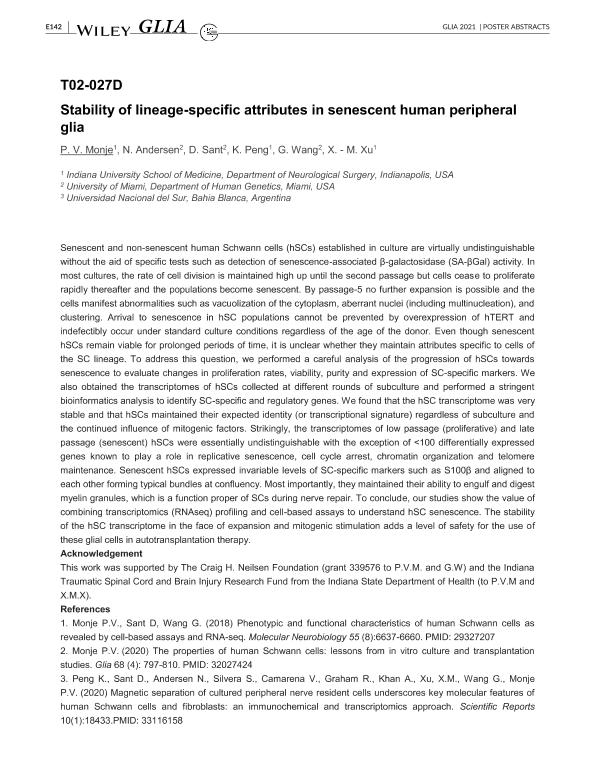Evento
Stability of lineage-specific attributes in senescent human peripheral glia
Tipo del evento:
Reunión
Nombre del evento:
XV European Meetingon Glial Cells in Health and Disease
Fecha del evento:
05/07/2021
Institución Organizadora:
European Glial Meeting;
Título del Libro:
Poster abstracts
Título de la revista:
Glia
Editorial:
John Wiley & Sons
ISSN:
0894-1491
e-ISSN:
1098-1136
Idioma:
Inglés
Clasificación temática:
Resumen
Senescent and non-senescent human Schwann cells (hSCs) established in culture are virtually undistinguishable without the aid of specific tests such as detection of senescence-associated β-galactosidase (SA-βGal) activity. In most cultures, the rate of cell division is maintained high up until the second passage but cells cease to proliferate rapidly thereafter and the populations become senescent. By passage-5 no further expansion is possible and the cells manifest abnormalities such as vacuolization of the cytoplasm, aberrant nuclei (including multinucleation), and clustering. Arrival to senescence in hSC populations cannot be prevented by overexpression of hTERT and indefectibly occur under standard culture conditions regardless of the age of the donor. Even though senescent hSCs remain viable for prolonged periods of time, it is unclear whether they maintain attributes specific to cells of the SC lineage. To address this question, we performed a careful analysis of the progression of hSCs towards senescence to evaluate changes in proliferation rates, viability, purity and expression of SC-specific markers. We also obtained the transcriptomes of hSCs collected at different rounds of subculture and performed a stringent bioinformatics analysis to identify SC-specific and regulatory genes. We found that the hSC transcriptome was very stable and that hSCs maintained their expected identity (or transcriptional signature) regardless of subculture and the continued influence of mitogenic factors. Strikingly, the transcriptomes of low passage (proliferative) and late passage (senescent) hSCs were essentially undistinguishable with the exception of <100 differentially expressed genes known to play a role in replicative senescence, cell cycle arrest, chromatin organization and telomere maintenance. Senescent hSCs expressed invariable levels of SC-specific markers such as S100β and aligned to each other forming typical bundles at confluency. Most importantly, they maintained their ability to engulf and digest myelin granules, which is a function proper of SCs during nerve repair. To conclude, our studies show the value of combining transcriptomics (RNAseq) profiling and cell-based assays to understand hSC senescence. The stability of the hSC transcriptome in the face of expansion and mitogenic stimulation adds a level of safety for the use of these glial cells in autotransplantation therapy.
Palabras clave:
SCHWANN CELLS
,
SENESCENCE
,
TRANSCRIPTOMICS
Archivos asociados
Licencia
Identificadores
Colecciones
Eventos(INIBIBB)
Eventos de INST.DE INVEST.BIOQUIMICAS BAHIA BLANCA (I)
Eventos de INST.DE INVEST.BIOQUIMICAS BAHIA BLANCA (I)
Citación
Stability of lineage-specific attributes in senescent human peripheral glia; XV European Meetingon Glial Cells in Health and Disease; Marseilles; Francia; 2021; 25-25
Compartir




